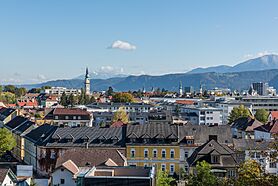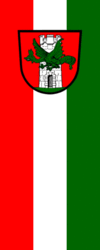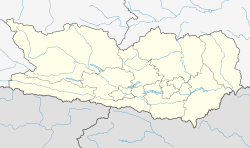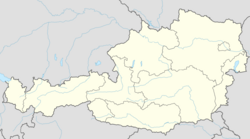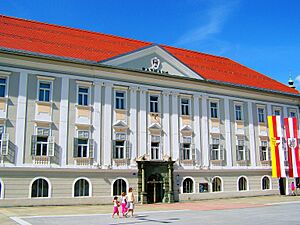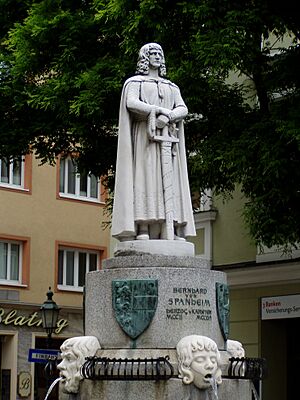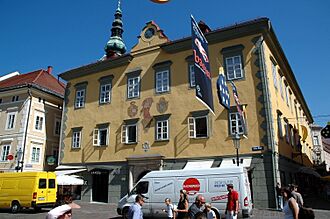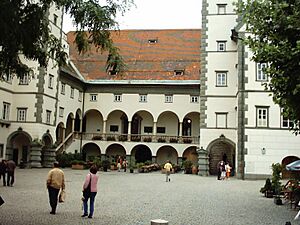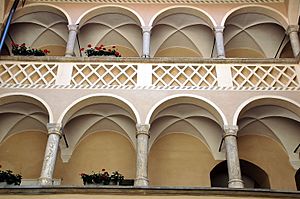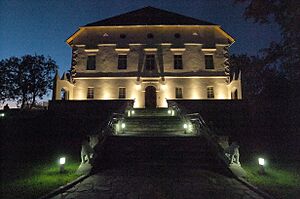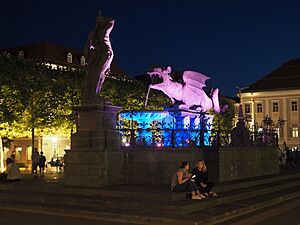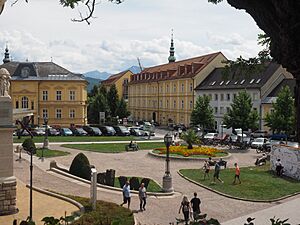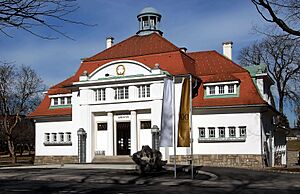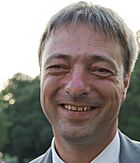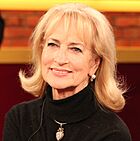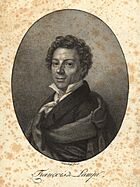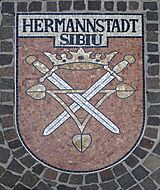Klagenfurt am Wörthersee facts for kids
Quick facts for kids
Klagenfurt am Wörthersee
Celovec (Slovene)
|
|||
|---|---|---|---|
|
Skyline of Klagenfurt
Trinity Column
Stadttheater Klagenfurt
Klagenfurt with Wörthersee Stadion
Klagenfurt Cathedral
Cathedral
Lendhafen Quarter
Klagenfurt from the Pyramidenkogel
Villa Samek
St. Egid
Wörthersee with Klagenfurt at the eastern end
|
|||
|
|||
| Country | Austria | ||
| State | Carinthia | ||
| District | Statutory city | ||
| Area | |||
| • Total | 120.12 km2 (46.38 sq mi) | ||
| Elevation | 446 m (1,463 ft) | ||
| Time zone | UTC+1 (CET) | ||
| • Summer (DST) | UTC+2 (CEST) | ||
| Postal code |
9020, 9061, 9063, 9065, 9073, 9201
|
||
| Area code | 0463 | ||
| Vehicle registration | K | ||
| Website | www.klagenfurt.at | ||
Klagenfurt am Wörthersee, usually called Klagenfurt, is a major city in Austria. It is the capital and largest city of the state of Carinthia. Klagenfurt is also the sixth-largest city in Austria.
The city is home to the University of Klagenfurt and other important schools. It is also a cultural hub for the Carinthian Slovenes, who are one of Austria's native minority groups. Klagenfurt is known for its beautiful location near Wörthersee lake.
Contents
City Name and Meaning
The name Klagenfurt means 'ford of lament' or 'ford of complaints'. Experts have different ideas about where this name came from. Some think it relates to old stories about spirits living near dangerous waters.
Another idea is that the name came from the Slovene name Celovec. This name might have meant 'place at or in the water'.
People in the past also tried to explain the name. One story says it came from the "lament" (Klagen) of citizens. This happened after a baker's helper was wrongly accused and executed.
In 2007, the city officially added "am Wörthersee" to its name. This means "on Lake Wörth". However, most people still just call it Klagenfurt.
City History
How Klagenfurt Started
A legend says Klagenfurt began after brave men defeated a winged "lindwurm" (a dragon-like creature). This creature lived in the nearby swamps and attacked the duchy. The story says a tower was built to watch for the dragon. The dragon was caught using a bull with a chain and hook. A village then grew where the battle happened. This village later became a town. A large 9-ton monument in the city center celebrates this story.
Historically, Duke Herman of Spanheim founded the first settlement. It was a strong point on important trade routes. This first settlement was often flooded. So, in 1246, Duke Bernhard von Spanheim moved it to a safer place. He is seen as the true founder of the city. Klagenfurt received its city rights in 1252.
Challenges and Growth in Medieval Times
Over the next few centuries, Klagenfurt faced many problems. It suffered from fires, earthquakes, and attacks. There were also invasions of locusts and peasant wars. In 1514, a big fire almost destroyed the city.
Emperor Maximilian I could not rebuild it. So, in 1518, he gave Klagenfurt to the local nobility. This was a very unusual event. The new owners, however, helped the city grow. They brought new wealth and power to Klagenfurt.
A canal was dug to connect the city to the lake. This helped bring timber for rebuilding. It also filled the city's new moats. Noble families built their homes in the city. The city was expanded with a new, planned layout. A new main square, the Neuer Platz, was built. Strong new walls were also constructed. These walls took 50 years to build. They made Klagenfurt one of the strongest fortresses north of the Alps.
The Industrial Era and Changes
In 1809, French troops under Napoleon destroyed most of the city walls. They left only one gate, which was later removed. A small part of the western wall is all that remains today.
In 1863, a railway connection helped the city's economy. The Vienna-Trieste railway also boosted Klagenfurt. It made the city a key regional center.
During the 1800s, Klagenfurt became important for Carinthian Slovene culture. Many important Slovene figures lived or studied here. These included Anton Martin Slomšek, a bishop, and France Prešeren, a national poet. The Hermagoras Society, a Slovene publishing house, was founded in Klagenfurt in 1851. Several Slovene newspapers were also printed in the city. However, by the late 1800s, Slovene influence in Klagenfurt decreased. By the end of World War I, the city was mostly Austrian German.
In 1919, the city was occupied by the army of the Kingdom of Yugoslavia. They claimed Klagenfurt for their new kingdom. However, after a vote in October 1920, most people chose to stay part of Austria. The Yugoslav forces then left the city.
Klagenfurt During World War II
In 1938, Klagenfurt grew a lot. Several nearby towns became part of the city. But during World War II, Klagenfurt was bombed 41 times. These bombings killed 612 people. Many buildings were destroyed or damaged. A huge amount of rubble had to be cleared.
As the war ended in 1945, leaders tried to protect the city. On May 3, 1945, Klagenfurt was declared an "open city". This meant it would not be defended if Allied forces attacked. This helped prevent more destruction.
On May 8, 1945, British troops entered Klagenfurt. They were met by the city's new democratic leaders. Later that day, Yugoslav forces also arrived. There was some tension between the British and Yugoslav troops. After several days, the Yugoslav troops left the main city area.
The British Eighth Army set up its headquarters in Klagenfurt. Carinthia became part of the British occupation zone in Austria. This lasted until 1955.
| Historical population | ||
|---|---|---|
| Year | Pop. | ±% |
| 1910 | 45,161 | — |
| 1923 | 43,536 | −3.6% |
| 1934 | 53,000 | +21.7% |
| 1939 | 61,286 | +15.6% |
| 1951 | 68,187 | +11.3% |
| 1961 | 75,684 | +11.0% |
| 1971 | 82,840 | +9.5% |
| 1981 | 87,321 | +5.4% |
| 1991 | 89,415 | +2.4% |
| 2001 | 90,141 | +0.8% |
| 2011 | 94,483 | +4.8% |
| 2018 | 100,316 | +6.2% |
Modern Klagenfurt
In 1961, Klagenfurt created Austria's first pedestrian zone. This was a special area for people to walk, without cars. Klagenfurt also started making "sister city" partnerships with cities in other countries. Its first partner was Wiesbaden, Germany, in 1930. Because of these many partnerships, Klagenfurt was named "European City of the Year" in 1968.
The city has also won the Europa Nostra Diploma of Merit three times. This award is for excellent work in restoring its old city center. This is a record for any European city.
In 1973, Klagenfurt grew again. It took in four more nearby areas. This made the city's population grow to about 90,000 people.
City Geography
Where Klagenfurt is Located
Klagenfurt is in southern Austria. It is close to the border with Slovenia. The city is about halfway between Innsbruck in the west and Vienna in the northeast.
Klagenfurt is 446 metres (1,463 feet) above sea level. It covers an area of about 120.03 square kilometres (46+3⁄8 sq mi). The city is located on Wörthersee lake and the Glan river. It is surrounded by hills and mountains covered in forests. These mountains can be up to 1,000 m (3,300 ft) high. To the south, the Karawanken mountains separate Carinthia from Slovenia and Italy.
How Klagenfurt is Organized
Klagenfurt is a statutory city in Carinthia. This means it is its own administrative district. It is also the main city for the larger Klagenfurt-Land district. Klagenfurt is divided into 16 smaller areas:
- I–IV Innere Stadt
- V St. Veiter Vorstadt
- VI Völkermarkter Vorstadt
- VII Viktringer Vorstadt
- VIII Villacher Vorstadt
- IX Annabichl
- X St. Peter
- XI St. Ruprecht
- XII St. Martin
- XIII Viktring
- XIV Wölfnitz
- XV Hörtendorf
- XVI Welzenegg
It is also divided into 25 smaller land units called Katastralgemeinden.
Klagenfurt's Climate
Klagenfurt has a humid continental climate. This means it has warm, wet summers with many thunderstorms. Winters are usually cold. Sometimes, warmer periods happen due to a special wind called foehn wind. Fog is common in autumn and winter.
On average, the temperature from 1991 to 2020 was 9.9 °C (49.8 °F). The city gets about 70 days a year where the temperature is 25 °C (77 °F) or higher. About 18 days a year reach 30 °C (86 °F). Snow covers the ground for about 52 days a year.
| Climate data for Klagenfurt (1991–2020 normals, extremes 1961-2020, humidity and dew point 1961-1990) | |||||||||||||
|---|---|---|---|---|---|---|---|---|---|---|---|---|---|
| Month | Jan | Feb | Mar | Apr | May | Jun | Jul | Aug | Sep | Oct | Nov | Dec | Year |
| Record high °C (°F) | 16.4 (61.5) |
21.5 (70.7) |
24.0 (75.2) |
28.2 (82.8) |
32.4 (90.3) |
37.1 (98.8) |
38.1 (100.6) |
37.8 (100.0) |
31.6 (88.9) |
26.3 (79.3) |
21.5 (70.7) |
16.6 (61.9) |
38.1 (100.6) |
| Mean daily maximum °C (°F) | 1.5 (34.7) |
5.7 (42.3) |
11.2 (52.2) |
16.6 (61.9) |
20.7 (69.3) |
25.2 (77.4) |
26.2 (79.2) |
25.5 (77.9) |
20.8 (69.4) |
14.4 (57.9) |
7.5 (45.5) |
1.4 (34.5) |
14.7 (58.5) |
| Daily mean °C (°F) | −2.1 (28.2) |
0.4 (32.7) |
5.6 (42.1) |
10.4 (50.7) |
15.2 (59.4) |
19.0 (66.2) |
20.7 (69.3) |
20.3 (68.5) |
15.4 (59.7) |
10.3 (50.5) |
4.4 (39.9) |
−1.3 (29.7) |
9.9 (49.7) |
| Mean daily minimum °C (°F) | −5.6 (21.9) |
−4.8 (23.4) |
−0.4 (31.3) |
4.3 (39.7) |
8.7 (47.7) |
12.8 (55.0) |
13.9 (57.0) |
13.7 (56.7) |
10.0 (50.0) |
5.5 (41.9) |
1.3 (34.3) |
−3.9 (25.0) |
4.6 (40.3) |
| Record low °C (°F) | −27.8 (−18.0) |
−25.6 (−14.1) |
−21.1 (−6.0) |
−5.9 (21.4) |
−3.8 (25.2) |
−0.6 (30.9) |
3.0 (37.4) |
3.4 (38.1) |
−1.6 (29.1) |
−8.9 (16.0) |
−17.4 (0.7) |
−21.8 (−7.2) |
−27.8 (−18.0) |
| Average precipitation mm (inches) | 27.0 (1.06) |
38.0 (1.50) |
46.3 (1.82) |
63.1 (2.48) |
85.6 (3.37) |
105.0 (4.13) |
119.0 (4.69) |
130.8 (5.15) |
102.1 (4.02) |
90.9 (3.58) |
84.8 (3.34) |
50.4 (1.98) |
943 (37.12) |
| Average precipitation days (≥ 1.0 mm) | 4.3 | 4.6 | 5.5 | 8.1 | 9.9 | 10.3 | 10.6 | 10.6 | 8 | 7.7 | 7.7 | 5.6 | 92.9 |
| Average relative humidity (%) | 88 | 82 | 75 | 69 | 69 | 70 | 71 | 75 | 81 | 84 | 89 | 90 | 79 |
| Average dew point °C (°F) | −5.5 (22.1) |
−3.9 (25.0) |
−1.4 (29.5) |
2.2 (36.0) |
7.3 (45.1) |
10.8 (51.4) |
12.8 (55.0) |
12.9 (55.2) |
10.5 (50.9) |
5.7 (42.3) |
0.4 (32.7) |
−4.0 (24.8) |
4.0 (39.2) |
| Mean monthly sunshine hours | 94.5 | 135.2 | 187.7 | 197.1 | 230.8 | 239.2 | 257.1 | 248.4 | 191.9 | 134.7 | 68.1 | 67.8 | 2,052.5 |
| Source: NOAA NCEI | |||||||||||||
| Climate data for Klagenfurt (1981–2010) | |||||||||||||
|---|---|---|---|---|---|---|---|---|---|---|---|---|---|
| Month | Jan | Feb | Mar | Apr | May | Jun | Jul | Aug | Sep | Oct | Nov | Dec | Year |
| Record high °C (°F) | 15.7 (60.3) |
21.5 (70.7) |
24.0 (75.2) |
27.0 (80.6) |
32.4 (90.3) |
35.3 (95.5) |
35.8 (96.4) |
36.6 (97.9) |
30.7 (87.3) |
25.2 (77.4) |
21.5 (70.7) |
16.6 (61.9) |
36.6 (97.9) |
| Mean daily maximum °C (°F) | 0.6 (33.1) |
4.8 (40.6) |
10.7 (51.3) |
15.6 (60.1) |
21.0 (69.8) |
24.2 (75.6) |
26.5 (79.7) |
25.6 (78.1) |
20.7 (69.3) |
14.6 (58.3) |
6.7 (44.1) |
1.1 (34.0) |
14.3 (57.7) |
| Daily mean °C (°F) | −2.8 (27.0) |
−0.4 (31.3) |
4.3 (39.7) |
9.3 (48.7) |
14.4 (57.9) |
17.8 (64.0) |
19.8 (67.6) |
19.0 (66.2) |
14.3 (57.7) |
9.3 (48.7) |
3.1 (37.6) |
−1.4 (29.5) |
8.9 (48.0) |
| Mean daily minimum °C (°F) | −7.1 (19.2) |
−5.6 (21.9) |
−1.2 (29.8) |
3.4 (38.1) |
8.4 (47.1) |
11.8 (53.2) |
13.5 (56.3) |
13.2 (55.8) |
9.3 (48.7) |
5.1 (41.2) |
−0.2 (31.6) |
−4.8 (23.4) |
3.8 (38.8) |
| Record low °C (°F) | −25.1 (−13.2) |
−25.6 (−14.1) |
−18.8 (−1.8) |
−5.9 (21.4) |
−2.0 (28.4) |
2.1 (35.8) |
3.0 (37.4) |
3.4 (38.1) |
−1.0 (30.2) |
−8.9 (16.0) |
−17.4 (0.7) |
−21.8 (−7.2) |
−25.6 (−14.1) |
| Average precipitation mm (inches) | 26 (1.0) |
29 (1.1) |
51 (2.0) |
62 (2.4) |
80 (3.1) |
105 (4.1) |
113 (4.4) |
126 (5.0) |
92 (3.6) |
84 (3.3) |
76 (3.0) |
51 (2.0) |
893 (35.2) |
| Average relative humidity (%) (at 14:00) | 76.5 | 60.7 | 52.0 | 48.7 | 49.2 | 50.1 | 49.1 | 51.3 | 55.3 | 63.6 | 74.0 | 80.6 | 59.3 |
| Mean monthly sunshine hours | 90 | 140 | 170 | 184 | 223 | 226 | 255 | 239 | 189 | 128 | 74 | 62 | 1,981 |
| Percent possible sunshine | 35.7 | 53.3 | 49.8 | 48.9 | 50.8 | 51.1 | 57.1 | 57.6 | 53.0 | 41.3 | 27.0 | 24.8 | 45.9 |
| Source: Central Institute for Meteorology and Geodynamics | |||||||||||||
| Climate data for Klagenfurt (1971–2000) | |||||||||||||
|---|---|---|---|---|---|---|---|---|---|---|---|---|---|
| Month | Jan | Feb | Mar | Apr | May | Jun | Jul | Aug | Sep | Oct | Nov | Dec | Year |
| Record high °C (°F) | 16.4 (61.5) |
21.5 (70.7) |
24.0 (75.2) |
26.7 (80.1) |
31.4 (88.5) |
33.1 (91.6) |
35.8 (96.4) |
35.5 (95.9) |
29.7 (85.5) |
26.3 (79.3) |
18.3 (64.9) |
16.6 (61.9) |
35.8 (96.4) |
| Mean daily maximum °C (°F) | 0.3 (32.5) |
4.4 (39.9) |
10.3 (50.5) |
14.9 (58.8) |
20.2 (68.4) |
23.4 (74.1) |
25.5 (77.9) |
25.1 (77.2) |
20.6 (69.1) |
14.2 (57.6) |
5.8 (42.4) |
0.8 (33.4) |
13.8 (56.8) |
| Daily mean °C (°F) | −4 (25) |
−1.4 (29.5) |
3.6 (38.5) |
8.3 (46.9) |
13.7 (56.7) |
16.9 (62.4) |
18.8 (65.8) |
18.2 (64.8) |
13.8 (56.8) |
8.2 (46.8) |
1.7 (35.1) |
−2.7 (27.1) |
7.9 (46.2) |
| Mean daily minimum °C (°F) | −7.2 (19.0) |
−5.4 (22.3) |
−1.3 (29.7) |
2.8 (37.0) |
7.8 (46.0) |
11.1 (52.0) |
12.9 (55.2) |
12.7 (54.9) |
9.0 (48.2) |
4.3 (39.7) |
−1 (30) |
−5.2 (22.6) |
3.4 (38.1) |
| Record low °C (°F) | −25.1 (−13.2) |
−25.6 (−14.1) |
−19.1 (−2.4) |
−5.9 (21.4) |
−2.2 (28.0) |
1.9 (35.4) |
3.0 (37.4) |
3.4 (38.1) |
−1.6 (29.1) |
−8.9 (16.0) |
−17.4 (0.7) |
−28.1 (−18.6) |
−28.1 (−18.6) |
| Average precipitation mm (inches) | 30.9 (1.22) |
35.2 (1.39) |
50.2 (1.98) |
64.5 (2.54) |
78.5 (3.09) |
113.5 (4.47) |
117.6 (4.63) |
98.6 (3.88) |
89.7 (3.53) |
82.9 (3.26) |
78.9 (3.11) |
48.9 (1.93) |
889.4 (35.02) |
| Average snowfall cm (inches) | 17.5 (6.9) |
20.4 (8.0) |
9.9 (3.9) |
5.1 (2.0) |
0.8 (0.3) |
0.0 (0.0) |
0.0 (0.0) |
0.0 (0.0) |
0.0 (0.0) |
0.3 (0.1) |
10.1 (4.0) |
20.0 (7.9) |
84.1 (33.1) |
| Average precipitation days (≥ 1.0 mm) | 5.1 | 4.9 | 6.2 | 8.0 | 9.6 | 11.5 | 10.2 | 9.4 | 7.2 | 7.3 | 7.1 | 5.4 | 91.9 |
| Average relative humidity (%) (at 14:00) | 78.0 | 63.9 | 52.6 | 47.8 | 49.0 | 50.6 | 50.3 | 51.4 | 65.8 | 63.0 | 76.1 | 81.9 | 60.0 |
| Mean monthly sunshine hours | 78.8 | 123.0 | 158.3 | 175.2 | 212.5 | 217.5 | 241.2 | 233.0 | 180.5 | 125.6 | 66.0 | 57.4 | 1,869 |
| Percent possible sunshine | 31.2 | 46.6 | 46.2 | 46.5 | 48.5 | 49.2 | 53.9 | 56.1 | 50.7 | 40.8 | 24.1 | 23.1 | 43.1 |
| Source: Central Institute for Meteorology and Geodynamics | |||||||||||||
City Population
As of January 2020, Klagenfurt had 101,403 residents. About 20,000 people living in Klagenfurt in 2019 were born outside Austria. This was about 20% of the city's total population.
| Largest groups of foreign residents | |
| Nationality | Population (2018) |
|---|---|
| 2,465 | |
| 1,977 | |
| 1,695 | |
| 1,342 | |
| 832 | |
| 650 | |
| 626 | |
Places to See
The Old City is a popular spot. It has a main square called Alter Platz (Old Square). You can see many Renaissance buildings there. These buildings have lovely courtyards with arches.
Other famous places to visit include:
- The Lindworm fountain from 1593. It has a statue of Hercules added in 1633.
- The Landhaus, which is the Palace of the Estates. It is now where the State Assembly meets.
- The Baroque cathedral, built by the Protestant nobility of Carinthia.
- Viktring Abbey, a large monastery.
- Wörthersee Stadion, a football stadium.
- Minimundus, a "small world" park near Lake Wörthersee. It has miniature models of famous buildings.
- The Kreuzbergl Nature Park. It has a viewing tower and an observatory.
- A small but nice botanical garden at the foot of Kreuzbergl. It also has a mining museum.
- The University Campus at the west end of the city. Next to it is the Lakeside Science & Technology Park.
- Wörthersee lake, which is one of the warmest large Alpine lakes. It has Europe's biggest non-sea beach.
- Maria Loretto peninsula, with its recently restored stately home.
- Tentschach and Hallegg castles.
City Economy
Klagenfurt is the main economic center of Carinthia. About 20% of the state's industrial companies are here. In 2001, over 63,000 people worked in 6,184 companies. The main industries are light industry, electronics, and tourism. There are also several printing companies.
The most important market in Klagenfurt is Benedikterplatz. It has been a market since 1948. You can find a wide variety of food for sale there twice a week.
Klagenfurt also has several shopping centres. The City-Arkaden shopping center opened in 2006. It is in the northern part of the city center. It has 120 shops and is one of the largest in Carinthia.
The second largest shopping center is Südpark. It opened in 1998 and is near the Klagenfurt central station.
Transportation in Klagenfurt
Klagenfurt Airport is an international airport. It has flights to many big European cities and holiday spots.
The Klagenfurt central station is south of the city center. It is the main train station.
The city is located where two major highways meet: the A2 and S37 motorways. The A2 goes from Vienna to Villach and then to Italy. The S37 goes from Vienna to Klagenfurt. The B91 highway goes to Ljubljana, the capital of Slovenia. Ljubljana is only 88 km (55 mi) from Klagenfurt.
Klagenfurt has a lot of car traffic. The city used to have streetcars and trolleybuses, but these stopped in 1963. There are 28 bus lines in the city. Even with many underpasses for main roads, traffic jams are common.
City Culture
Klagenfurt has a civic theatre and opera house. It has professional groups and a symphony orchestra. There is also a university for music and a concert hall. You can find musical societies and an experimental theatre company.
The city has the State Museum for Carinthia and a modern art museum. There is also a museum for religious art. Other cultural spots include the Artists' House and several art galleries. The planetarium in Europa Park is also popular. Literary places like the Robert Musil House are here too. Klagenfurt hosts the important Ingeborg Bachmann Prize for German literature.
Klagenfurt has several small publishing houses. Many newspapers are also published here. These include "Kleine Zeitung" and "Kärntner Krone".
Klagenfurt is a popular place for vacations. It has mountains to the north and south. There are many parks and 23 stately homes and castles nearby. In summer, the city holds the Altstadtzauber (The Magic of the Old City) festival.
Several Carinthian Slovene cultural groups are based in Klagenfurt. This includes the Hermagoras Society, the oldest Slovene publishing house.
Annual Events and Festivals
Klagenfurt hosts many events each year:
- Annual lectures and discussions for the international Ingeborg Bachmann literature awards.
- An international summer music concert and Gustav Mahler awards ceremony at Viktring Abbey.
- The "Wörthersee Classics" festival at the concert house.
- The World Bodypainting Festival, a famous body painting event in July.
- The "Kontaktna-leča – Kontaklinse-Festival" for youth culture. This event is organized by Slovenian students.
- The "Altstadtzauber" ("Old Town Magic") music and arts festival in August.
- The Klagenfurt Festival, held since 2020.
- A Christmas market held every year during the Christmas season.
Education in Klagenfurt
Klagenfurt is an important center for education. It is home to the University of Klagenfurt. It also has a campus of the Fachhochschule Kärnten (Carinthia University of Applied Sciences). There are colleges for teacher training and further education.
The city also has a Slovene language Gymnasium (a type of high school) and a Slovene language commercial high school.
Universities and Colleges
- University of Klagenfurt
- Klagenfurt Campus of Fachhochschule (FH) Kärnten (Carinthia University of Applied Sciences)
- Pädagogische Hochschule Viktor Frankl, a college of education
- Health Science Centre with Academy for Midwifery and hospital-based Nursing school
- Gustav Mahler University of Music
High Schools
Klagenfurt has several general high schools:
- Europa-Gymnasium, Austria's second-oldest
- BG/BRG Mössingerstraße
- BRG Klagenfurt-Viktring (focuses on arts like music and drawing)
- ORG St. Ursula, a private Catholic school
- Federal Gymnasium for Slovenes
There are also senior high schools that offer both general and professional education:
- Two schools of Engineering: HTL Lastenstrasse and HTL Mössingerstraße
- Two commercial high schools: Handelsakademie No. 1 and No. 2
- A Slovene-language Commercial High School ("Handelsakademie")
- A high school for catering, fashion, and design
- A school for pre-school education
- A school for Alpine agriculture and nutrition science
- A school for social management run by the Caritas charity
Further Education and Other Schools
- College of Further Education Volkshochschule
- Technical Training Institute of the Trade unions, Berufsförderungsinstitut (BFI)
- Technical Training Institute of the Chamber of commerce, Wirtschaftsförderungsinstitut (WIFI)
- Evening schools (for Gymnasium and Engineering)
- Waldorf School
- A school for social workers by the Austrian Caritas Charity
- Carinthian State school of Fire Control
Sports in Klagenfurt
Klagenfurt is home to the ice hockey team EC KAC. This team has won the Austrian Championship 30 times since 1909.
The Bundesliga football club SK Austria Kärnten was based here. Its new club, Austria Klagenfurt, also plays in the city.
Klagenfurt hosts the start and finish of the Austrian Ironman Triathlon Contest. This event includes a 3.8 km (2+3⁄8 mi) swim, 180 km (112 mi) bike ride, and a 42 km (26 mi) run.
The World Rowing Championships were held on the Wörthersee lake in 1969. The 2016 Beach Volleyball Major Series also took place in Klagenfurt.
Klagenfurt hosted three games during the UEFA Euro 2008 at the Wörthersee Stadion. The city also has an American football team, the Carinthian Black Lions. They play in the First League of the Austrian Football League.
Famous People from Klagenfurt
Public Service and Diplomacy
- Bernhard von Spanheim (1176 or 1181 – 1256), a Duke of Carinthia for 54 years.
- Maximilian Daublebsky von Sterneck (1829–1897), an Admiral in the Austro-Hungarian Navy.
- Wolfgang Petritsch (born 1947), a diplomat and former UN High Representative.
- Valentin Inzko (born 1949), a diplomat and High Representative for Bosnia and Herzegovina.
- Ursula Plassnik (born 1956), a diplomat and former Foreign Minister of Austria.
- Prince Stefan of Liechtenstein (born 1961), Liechtenstein's Ambassador to Germany.
- John of Viktring (ca. 1270–1347), a medieval writer and political advisor.
- Jurij Japelj (1744–1807), a Slovene priest and language expert.
- Matija Majar (1809–1892), a Slovene priest and political activist.
- Andrej Einspieler (1813–1888), a Slovene politician and journalist.
- Anton Janežič (1828–1869), a Slovene language expert and historian.
- Emanuel Herrmann (1839–1902), an economist who created the pre-paid postal card.
- Rudi Vouk (born 1965), a lawyer, politician, and human rights activist.
Science and Architecture
- Lorenz Chrysanth von Vest (1776–1840), a doctor and botanist.
- Friedrich Welwitsch (1806–1872), an explorer and botanist.
- Josef Stefan (1835–1893), a Slovene physicist, mathematician, and poet.
- Hubert Leitgeb (1835–1888), a botanist.
- Roland Rainer (1910–2004), a famous architect.
- Günther Domenig (1934–2012), an architect.
- Peter Manfred Gruber (born 1941), a mathematician.
- Andreas Bernkop-Schnürch (born 1965), a scientist and inventor.
Writers and Artists

- Robert Musil (1880–1942), a philosophical writer.
- Ingeborg Bachmann (1926–1973), a famous poet and author.
- Gert Jonke (1946–2009), a poet, playwright, and novelist.
- Antonia Rados (born 1953), a television journalist.
- Udo Jürgens (1934–2014), an Austrian-Swiss singer who won Eurovision.
- Dagmar Koller (born 1939), a singer and actress.
- Wolfgang Puschnig (born 1956), a jazz musician.
- Franciszek Ksawery Lampi (1782–1852), a Polish Romantic painter.
- Wolfgang Hollegha (born 1929), a painter.
- James Aubrey (1947–2010), a British actor.
- Danny Nucci (born 1968), an Austrian-American actor.
- Larissa-Antonia Marolt (born 1992), a fashion model and actress.
Sports Figures
- Andre Burakovsky (born 1995), an ice hockey player.
- Rosa Donner, (born 2003), a competitive sailor.
- Stephanie Graf (born 1973), a former middle-distance runner.
- Dieter Kalt, Jr. (born 1974), a former professional ice hockey player.
- Stefan Lexa (born 1976), a retired football player.
- Stefan Koubek (born 1977), a retired tennis player.
- Thomas Pöck (born 1981), an ice hockey player.
- Horst Skoff (1968–2008), a professional tennis player.
Images for kids
-
A2 autobahn by-pass at Falkenberg tunnel
-
Empress Maria Theresa on Neuer Platz
Sister Cities
Klagenfurt is connected with many cities around the world. These are called "sister cities" or "twin towns". This helps build friendships and understanding between different places.
 Wiesbaden, Hesse, Germany, since 1930
Wiesbaden, Hesse, Germany, since 1930 Venlo, Limburg, Netherlands, since 1961
Venlo, Limburg, Netherlands, since 1961 Nova Gorica, Slovenia, since 1965
Nova Gorica, Slovenia, since 1965 Gorizia, Gorizia, Friuli-Venezia Giulia, Italy, since 1965
Gorizia, Gorizia, Friuli-Venezia Giulia, Italy, since 1965 Gladsaxe, Denmark, since 1969
Gladsaxe, Denmark, since 1969 Dessau-Roßlau, Saxony-Anhalt, Germany, since 1970
Dessau-Roßlau, Saxony-Anhalt, Germany, since 1970 Dushanbe, Tajikistan, since 1973
Dushanbe, Tajikistan, since 1973 Dachau, Bavaria, Germany, since 1974
Dachau, Bavaria, Germany, since 1974 Rzeszów, Podkarpackie Voivodeship, Poland, since 1975
Rzeszów, Podkarpackie Voivodeship, Poland, since 1975 Sibiu, Romania, since 1990
Sibiu, Romania, since 1990 Zalaegerszeg, Hungary, since 1990
Zalaegerszeg, Hungary, since 1990 Chernivtsi, Ukraine, since 1992
Chernivtsi, Ukraine, since 1992 Nof Hagalil, Israel, since 1993
Nof Hagalil, Israel, since 1993 Tarragona, Tarragona, Catalonia, Spain, since 1994
Tarragona, Tarragona, Catalonia, Spain, since 1994 Nanning, China, since 2001
Nanning, China, since 2001 Laval, Québec, Canada, since 2005
Laval, Québec, Canada, since 2005 Lignano Sabbiadoro, Udine, Friuli-Venezia Giulia, Italy, since 2021
Lignano Sabbiadoro, Udine, Friuli-Venezia Giulia, Italy, since 2021 Koper, Slovenia, since 2022
Koper, Slovenia, since 2022
See also
 In Spanish: Klagenfurt para niños
In Spanish: Klagenfurt para niños


